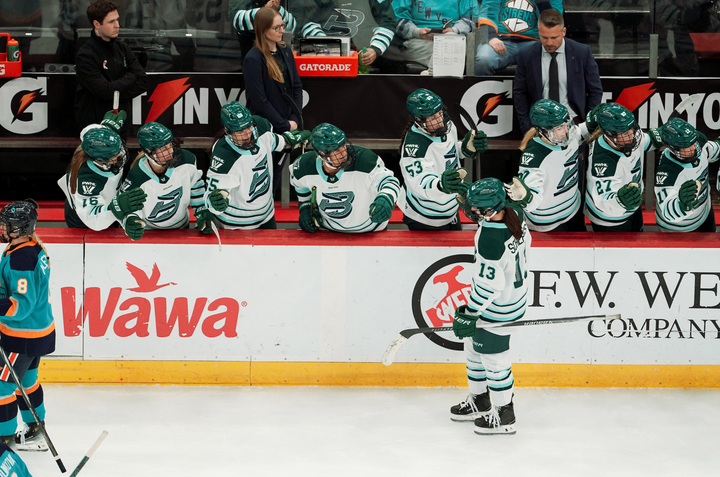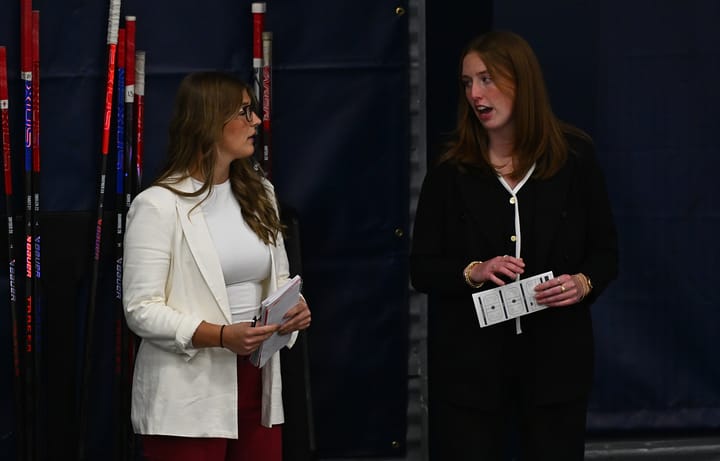Wicked Angles: A changing of the guard, and a complicated reality of pro women’s hockey today
Times are changing
“It’s like the more money we come across, the more problems we see,” goes the refrain of one of Biggie’s most popular hits, and nowhere might that be more true currently than in professional women’s hockey — admittedly not the first arena you think of when it comes to “Mo’ Money, Mo’ Problems.” Still, the lyric is apt for the sort of turn we’re seeing the PHF in particular take during the first of a three-season, $25 million investment by its Board of Governors to grow the league into a fully-fledged professional enterprise.
This work is long, and hard, and has come on the backs of athletes and builders who have each left their mark on the glass, each paved one more stone down the road to fill in the gaps and holes pro women’s hockey has dealt with over the past 15-plus years. Year Eight sees a bigger shift than ever before: one that moves the plates closer to a peak where the game and its players are stronger, better, making more money than they ever thought they could. One that, despite all the good for the current crop, might just be leaving some of its Day Ones in the dust.
Bright emerging stars like Brittany Howard and Corinne Schroeder are already lighting up the Fed, while some stalwarts like Madison Packer and Jillian Dempsey have been going strong since 2015. Still, we’re starting to notice that some of the game’s biggest players haven’t cracked rosters, haven’t gotten many looks. Players like Taylor Accursi are on PTOs instead of regular gameday lineups. Players like Elena Orlando and Rebecca Morse have effectively found themselves on the outside looking in. Obviously, there’s a bigger story behind all of these decisions — maybe it’s the player’s choice to step away, maybe they feel it’s for the best — but more than a couple of them have made it clear that it’s not.
It’s normal for the sport (any sport, really) to see this kind of change, and it’s all a part of the business. That’s the pragmatic way of looking at it — after all, those pouring the money in are going to want to see some kind of return on their investment. And sometimes what’s best for the player isn’t necessarily good for business.
Sometimes a full-time police officer can’t take multiple days off to go on a road trip, or a full-time nurse can’t drop everything to attend a team event despite wanting to still be a part of the team. Practices have increased in number; commitments have strengthened. It’s becoming much less “side job” and much more of an honest-to-God Profession, and yet for many, they still aren’t able to hinge on that. Commitment alone can’t put food on the table or pay your bills, and the money isn’t at a point yet where many players still feel comfortable making hockey their full-time job.
Taylor Accursi (Boston Pride Version)
— Boston Pride (@TheBostonPride) November 21, 2022
📸: Kayla Franz pic.twitter.com/daBsMcHOe5
With “more money” comes the problem of deciding whether or not to make that move, quit that job, sign that contract. With “more money” comes the problem of players making more, but still not making what they’re worth. With “more money” comes more options, more phone calls, more prospects vying for spots and coming to camps and hoping for a piece of a pie that hasn’t really gotten that much bigger yet. At least, not as big as it could be with a presumed minimum salary of $13,500 (just barely above the poverty line for the average single North American, both in the United States and Canada). Not where it could be for a league that hasn’t been around long enough for us to even get a good grasp of what the average player’s career length could be.
And still, the investment could be so much more — we could get the marketing, the communications, the exposure to a point where it could truly flourish as a venture. A point where there’s room for the old guard and the new blood. We could get the same kind of dedication U-20 boys’ players have gotten to make the World Juniors the international event it’s become, instead of what feels like a pretense of magnanimity, a sprinkling of crumbs we’re trying to stretch into a feast. Especially now, as viewership and demand for women’s sports seems to be at an all-time high even with limited exposure.
I’m definitely not trying to sound ungrateful, as the processes in place for the league today are several steps above where we started Year One — but that doesn’t mean the future is here yet. We’re only just entering a better sort of present day.
Hell, even a reserve squad or a B team, something that keeps players on the back burner in case of an injury or something else, would be better than what we have now. Something that doesn’t make it feel like athletes in their prime are being shunted to the sidelines because they can’t drop everything for crumbs. And a more reasonable expectation, one that eases these athletes into the reality of being professional athletes first and increases those expectations along with their salaries, would be beneficial for everyone.
Because it is a business, but it’s a business that is still growing, and it’s one where maybe a police officer can’t also be a full-time hockey player — but she should still be able to make that choice for herself.





Comments ()